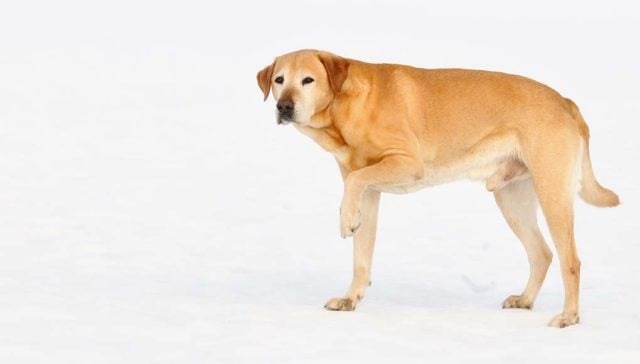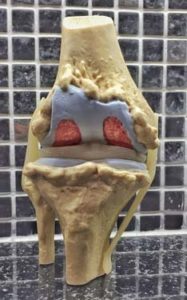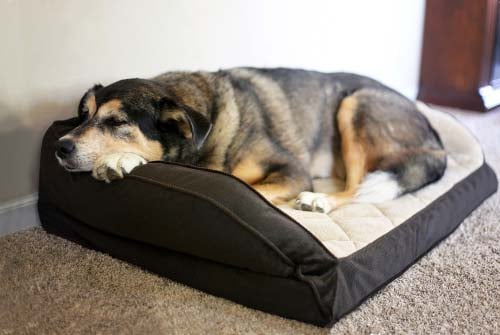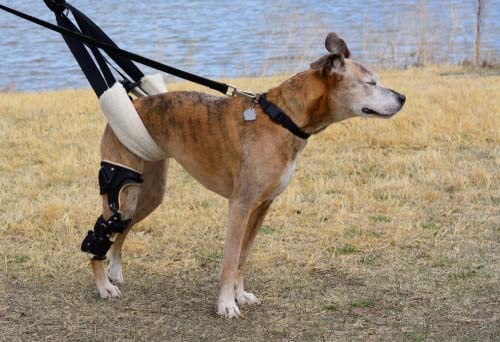
Table of Contents
Dogs can suffer from knee problems just like humans, and just like us, these problems can seriously affect their quality of life.
Knowing what the most common knee problems in dogs are and how to spot them can help you react quickly and ensure better recovery for your pooch.
Symptoms of Knee Problems in Dogs
Physical injuries in dogs can be spotted similarly to how we spot them in people.
Pay attention to your dog's behavior and movement whenever you're out on the walk or playing in the park.
Did your dog's moving patterns change? Does it look like he or she may be favoring one side of the body over the other, avoiding pressure on a specific leg? Catching the symptom earlier can be significant in faster and better recovery.
 Symptoms of dog knee problems can vary depending on the cause and severity of the issue. However, some of the most common signs include stiffness, soreness, and swelling of the knee, as well as limping, lameness, and skipping while walking or running. Pay attention to any signs of decreased mobility and reduced range of movement.
Symptoms of dog knee problems can vary depending on the cause and severity of the issue. However, some of the most common signs include stiffness, soreness, and swelling of the knee, as well as limping, lameness, and skipping while walking or running. Pay attention to any signs of decreased mobility and reduced range of movement.
Your dog may also exhibit more subtle signs that indicate pain, like decreased activity and alertness, loss of appetite, increased weight gain, and other behavior changes. These signs are not exclusive to knee issues in dogs but would be the first signal for you that something may be wrong and it's time to visit a vet.
ALSO READ: 8 Ways to Prevent Injuries in Dogs
Most Common Knee Problems in Dogs
While some of the dog knee problems are genetic and attributed to the pet's aging, others come as a result of different injuries and thus can be prevented or even treated quicker and more effectively. There are three common causes of knee problems in dogs:
- Arthritis
- Luxating Patella
- Cranial Cruciate Ligament Injuries
1. Arthritis
Arthritis in dogs is one of the most infamous disorders, generally occurring in senior or obese pets, and it's also one of the hardest to manage and treat. While it is not strictly a knee problem because it affects all of the dog’s joints and sometimes hips, it still affects the dog’s knees, which carry most of the animal's weight.
There's a variety of causes of arthritis, including infections, trauma, and stress to the joint surfaces. In some cases, it can be caused by disorders of the dog’s immune system. However, it is most often a result of genetic predisposition and simply aging, both of which lead to gradual joint degeneration and are nearly impossible to prevent and treat.
How to Prevent It:
While it's difficult to completely ensure your pet never has arthritis, proper diet and exercise can increase the chances of avoiding it for as long as possible. Provide your dog with enough physical exercise through playtime, walks, and training; keep your dog's weight in check to reduce the stress on his knees and other joints.
Well-balanced meals and dietary pet supplements like omega-3 fatty acids, glucosamine, and chondroitin can improve joint health. Providing your pooch with warm and appropriate bedding, like orthopedic dog beds, can also help, particularly in cold winter months, which can affect the health of the dog's joints.
Getting treatment for an existing orthopedic condition or injury as soon as possible can prevent arthritis from developing in the affected area.
How to Fix It:
While it is impossible to cure arthritis, with the right treatment, you can manage your dog’s condition and improve his quality of life. Some of the possible treatments include physical therapy (particularly hydrotherapy), anti-inflammatory and pain medication, natural joint remedies, pet massage, acupuncture, and finally, surgery.
If your dog is overweight, weight loss should be the first priority and can often drastically improve your pet's condition, combined with some of the other treatment options.
2. Luxating Patella
Luxating patella is a medical term for a dog's dislocated knee cap, which is a small and flat bone that protects the knee joint. During physical activity, the knee cap can become dislodged from the joint and usually slide right back into its position. This is not really painful, although it can be uncomfortable for your pooch. However, this condition can be more severe, especially if left untreated.
This issue is most commonly caused by direct trauma to the dog’s knee, although it can also be caused by a genetic predisposition. That’s why some small breeds like Chihuahuas, Pekingese, Poodles, and Pomeranians are more susceptible to having luxating patella. Also, breeds with short legs, like Dachshunds and Basset Hounds, are at higher risk because of their unusual anatomical structure.
How to Prevent It:
Generally, there's no way to know if your pup will develop this condition, and there's no way to prevent it. Dogs with a higher risk of suffering from Luxating Patella condition need to maintain a healthy weight with a nutritious, high-quality diet and carefully developed exercise regimens. Other than that, the only way to prevent luxating patella in dogs is to remove affected dogs from the breeding population.
How to Fix It:
Treatment will depend on the severity of the condition, which can range from Grade 1 to Grade 4. Mild cases are usually treated with supplements for bone health, administration of anti-inflammatory drugs like fish oil, and plenty of pet massages. In fact, a simple knee massage can relieve your dog of pain and help him regain his mobility. Acupuncture and hydrotherapy with underwater treadmills may also help.
More severe cases of such knee problems in dogs often require surgery, although knee braces are being used as an alternative since they can stabilize stifle joints, where this is applicable.
3. Cranial Cruciate Ligament (CCL) Injuries
Cranial Cruciate Ligament is a ligament that connects the back of the bone above the knee, called femur, with the front of the bone below the knee, called tibia. Its main function is to stabilize the dog's knee joint. CCL injuries in dogs are common and often extremely painful, similar to ACL injuries in humans.
Many things can cause CCL injuries in dogs, including your pet's activity levels, weight, age, and breed. Some breeds, like Retrievers, German Shepherds, and Rottweilers, are more likely to suffer a CCL rupture or tear. Older and obese dogs are also at a higher risk, as well as dogs that get occasional strenuous exercise.
However, dog CCL injuries commonly occur during everyday activities, like walking or jumping. Even if the animal's ligaments are healthy, the cranial cruciate ligament can rupture with one sudden wrong move.
How to Prevent It:
While this condition is difficult to prevent because it can happen so suddenly, if you keep your pooch at a healthy weight and provide regular, non-strenuous exercise so that the dog stays in good physical shape, you can significantly minimize the risk.
Even though CCL injuries are related to ligaments, proper nutrition to sustain or improve joint health is also very important, like with other dog knee problems.
How to Fix It:
Non-surgical treatment for this type of dog injury is typically reserved for canines that weigh less than 30 pounds. This includes rest and administration of anti-inflammatory drugs for 6 to 8 weeks. Gentle exercise and physical therapy can help, along with a strict weight loss regimen for obese dogs.
For larger dogs who weigh more than 30 pounds, surgery is the preferred option, with a rehabilitation period that lasts for more than 8 weeks. Follow your vet’s instructions closely during this period to ensure the best recovery outcome.
In Summary
 The three most common knee problems in dogs are arthritis, dislocated knee cap, and ligament (CCL) injuries. Their symptoms and causes vary, but they all result in decreased quality of life for the dog, where your pet experiences soreness, favoring, limping, and avoiding activity. All dog knee problems will be characterized by a limited range of motion, loss of mobility, lameness in hind legs, skipping while walking, and behavioral changes caused by pain.
The three most common knee problems in dogs are arthritis, dislocated knee cap, and ligament (CCL) injuries. Their symptoms and causes vary, but they all result in decreased quality of life for the dog, where your pet experiences soreness, favoring, limping, and avoiding activity. All dog knee problems will be characterized by a limited range of motion, loss of mobility, lameness in hind legs, skipping while walking, and behavioral changes caused by pain.
Common treatments for knee problems in dogs include the use of anti-inflammatory and pain medication, massaging the knee, physical therapy like hydrotherapy using underwater treadmills, weight loss and weight control regimen and, ultimately, surgery.
READ NEXT: 6 Signs of Back Problems in Dogs and What You Can Do About It















